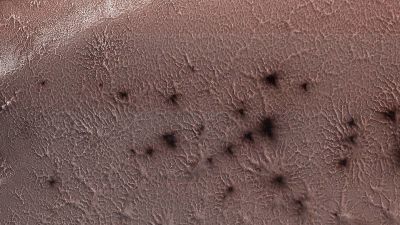OU scientists recreate 'spiders' on Mars

Ziggy Stardust may have sung about the Spiders from Mars, but scientists at the Open University in Milton Keynes, have managed to recreate them. The arachnids in question though aren't Martian versions of our eight-legged friends, but rather a pattern formed on the icy surface of the Red Planet. The team led by led by OU Postdoctoral Research Associate Dr Lauren McKeown carried out a series of experiments in a bid recreate the processes which would have led to the patterns. Nothing like it occurs on earth.
The team, which includes Trinity College Dublin and Durham University, used the OU's special Mars Simulation Chamber, to recreate the forces which would have created the patterning. The work has just been published in the journal Nature Scientific Reports.
The research, funded by Europlanet and the Irish Research Council, wanted to see if they could prove a theory behind the formation of the 'Martian spiders'. It was thought that the Spiders, properly known as araneiforms, occured through a process called sublimation - where a solid transforms into a gas without becoming liquid at any stage. The atmosphere of Mars is mainly made up of carbon dioxide and as temperatures plummet in the winter, it covers the surface as ice made from CO2. In spring, when the surface warms, the ice cracks releasing gas which then forms the spider patterning. Speaking to the OU Dr McKeown said :
The researchers drilled holes in the centres of blocks of CO2 ice and suspended these inside the chamber, the pressure was lowered to Martian atmospheric pressure and then the block was lowered to the surface. The results were patterns similar to those captured by Nasa's mars orbiter.
It comes as the OU was awarded £279,000 from the Government's National Space Innovation Programme. The fund is designed to support projects with international partners. It's working with the NASA Jet Propulsion Laboratory, Chelmsford-based Teledyne e2v and the Indian Space Research Organisation to develop space imaging technology. Just last month Teledyne e2v was involved in the Mars Perseverance probe landing on Mars.
Solar Orbiter built in Stevenage captures closest image of the sun
It is rocket science: the role of our region in future space travel